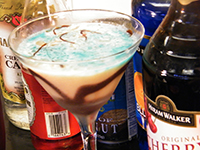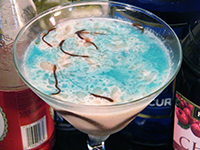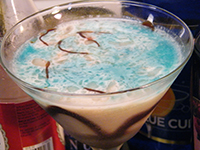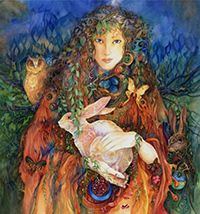 I might have never known how great this version of the Easter Egg Cocktail is if my friend Michelle hadn’t said, “Let’s go to the Townhouse Lounge”. An underappreciated, dark, loud, hipster bar in the heart of Midtown Sacramento, ToHo is also where Bartender Brian works. Michelle and I got far beyond wasted that afternoon, but one of the drinks that Brian made for us that day stuck out in my mind as one of the best drinks I’ve ever tasted. Although his version wasn’t this version, or even the popular version of this drink, I remember wondering what he was making with cream of coconut and blue curacao. Later, I would find out that this delectable drink was a variation of the Easter Egg Cocktail. I knew I had to find the recipe that was somewhat close to that shot, but it took time to find this particular recipe.
I might have never known how great this version of the Easter Egg Cocktail is if my friend Michelle hadn’t said, “Let’s go to the Townhouse Lounge”. An underappreciated, dark, loud, hipster bar in the heart of Midtown Sacramento, ToHo is also where Bartender Brian works. Michelle and I got far beyond wasted that afternoon, but one of the drinks that Brian made for us that day stuck out in my mind as one of the best drinks I’ve ever tasted. Although his version wasn’t this version, or even the popular version of this drink, I remember wondering what he was making with cream of coconut and blue curacao. Later, I would find out that this delectable drink was a variation of the Easter Egg Cocktail. I knew I had to find the recipe that was somewhat close to that shot, but it took time to find this particular recipe.
Easter Egg Cocktail

- 2 oz cream of coconut
- 1 oz white crème de cacao
- 1 oz cherry brandy
- 1 tsp blue curacao
- 1 tsp grenadine
- Maraschino cherry
In a chilled martini glass, drizzle chocolate syrup in swirl patterns. Pour cream of coconut, crème de cacao, and cherry brandy into a cocktail shaker filled with ice. Shake and strain into your martini glass. Drizzle blue curacao and grenadine on top of base cocktail mixture. You should get a speckled egg effect going on. Drop in your maraschino cherry and drizzle a bit more chocolate syrup on top to complete your colorful Easter Egg cocktail. Drink up and enjoy!
 There are several versions of this drink; this particular Easter Egg is more labor intensive than the ones with three ingredients. It takes about three minutes to serve this drink from set up to completion, but it is definitely worth every second. The Easter Egg Cocktail is a visually impressive drink, which also tastes amazing. The coconut, cherry brandy, creme de cacao, and blue curacao combine into something that is greater than the sum of their parts. If you’re looking for an Easter themed cocktail to serve guests, I would recommend you make the Easter Egg your flagship drink.
There are several versions of this drink; this particular Easter Egg is more labor intensive than the ones with three ingredients. It takes about three minutes to serve this drink from set up to completion, but it is definitely worth every second. The Easter Egg Cocktail is a visually impressive drink, which also tastes amazing. The coconut, cherry brandy, creme de cacao, and blue curacao combine into something that is greater than the sum of their parts. If you’re looking for an Easter themed cocktail to serve guests, I would recommend you make the Easter Egg your flagship drink.
How Did Eggs Become a Symbol of Easter?
There are many theories about how colored eggs became associated with Easter. The obvious symbolism is that the egg represents rebirth. The Hindus, Egyptians, Phoenicians, and Persians believed the world came from some sort of cosmic egg. These ancient cultures probably noticed the coincidence of the Spring Equinox with the changes made in nature, and could have merged these into some sort of tradition. The word Easter comes from the name of the ancient Anglo-Saxon goddess Estore, to which April was dedicated. A more practical explanation has to do with the celebration of Lent, which starts forty days before Easter, in which people have to give up something. Orthodox households would not eat dairy products during this period, but chickens would still lay eggs. Easter would be the first opportunity to use up the surplus of eggs.
 Coloring the eggs was probably first done by North African tribes in the Middle Ages, although Henry I of England was the first Westerner of record to order decorated eggs somewhere in the early 1000s. This soon became a tradition in England, as the wealthy classes would get eggs done up in gold foil, and the commoners would simply decorate eggs with flowers or herbs. In the 1600s, egg shaped toys were first exchanged, and later in the 1800s, the first chocolate eggs were made. Also in the 1800s, author Jakob Grimm put forth the assumption of a connection between the colored Easter eggs and the pagan goddess Estore, whom he referred to as Ostara. Modern pagan scholars say Estore was strictly an Anglo goddess, not mentioned at all in ancient Norse writings, and barely mentioned in Old English texts. Ostara is a Wiccan holiday which coincides with the vernal equinox, while Easter bounces around, according to where the moon is positioned.
Coloring the eggs was probably first done by North African tribes in the Middle Ages, although Henry I of England was the first Westerner of record to order decorated eggs somewhere in the early 1000s. This soon became a tradition in England, as the wealthy classes would get eggs done up in gold foil, and the commoners would simply decorate eggs with flowers or herbs. In the 1600s, egg shaped toys were first exchanged, and later in the 1800s, the first chocolate eggs were made. Also in the 1800s, author Jakob Grimm put forth the assumption of a connection between the colored Easter eggs and the pagan goddess Estore, whom he referred to as Ostara. Modern pagan scholars say Estore was strictly an Anglo goddess, not mentioned at all in ancient Norse writings, and barely mentioned in Old English texts. Ostara is a Wiccan holiday which coincides with the vernal equinox, while Easter bounces around, according to where the moon is positioned.







